The Cousin’s War
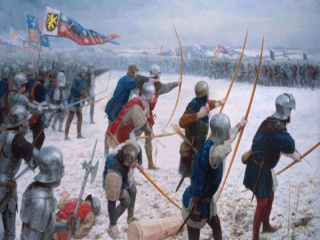 At Towton on March 29th, 1461 over 100,000 men fought all day in a blinding blizzard. The population of England in 1461 was under two million and so this one battle engaged 5% of the total population, or nearly 25% of men aged between 20 and 40.
Edward IV, at eighteen years of age, had declared himself King the previous day. Approximately 28,000 men died in this crucial test of wether he could fulfil his proclamation.
Many believed that he was the rightful King of England and were prepared to die to make that come about, but nothing about the “Wars of the Roses” is absolutely certain!
The Wars of the Roses is also called the “Cousins War” because this conflict was between two factions of the rulers of the Plantagenet Empire. The Empire they were fighting over nominally included England, Wales, Scotland, Ireland and most of what is today Northern and Western France. For a short period the Plantagenets also claimed Castile, which in turn was the largest part of what is now Spain. The Wars covered the period 1399-1505 and distracted the Plantagenets from the routine governance of their Empire. The wars were therefore a major contributor to the loss of Scotland and virtually all their European possessions. They had particularly unfortunate outcomes for the governance of Ireland.
The two sides in the conflict, chose roses as their symbols; the red rose for the house of Lancaster, the white rose for the house of York.
At Towton on March 29th, 1461 over 100,000 men fought all day in a blinding blizzard. The population of England in 1461 was under two million and so this one battle engaged 5% of the total population, or nearly 25% of men aged between 20 and 40.
Edward IV, at eighteen years of age, had declared himself King the previous day. Approximately 28,000 men died in this crucial test of wether he could fulfil his proclamation.
Many believed that he was the rightful King of England and were prepared to die to make that come about, but nothing about the “Wars of the Roses” is absolutely certain!
The Wars of the Roses is also called the “Cousins War” because this conflict was between two factions of the rulers of the Plantagenet Empire. The Empire they were fighting over nominally included England, Wales, Scotland, Ireland and most of what is today Northern and Western France. For a short period the Plantagenets also claimed Castile, which in turn was the largest part of what is now Spain. The Wars covered the period 1399-1505 and distracted the Plantagenets from the routine governance of their Empire. The wars were therefore a major contributor to the loss of Scotland and virtually all their European possessions. They had particularly unfortunate outcomes for the governance of Ireland.
The two sides in the conflict, chose roses as their symbols; the red rose for the house of Lancaster, the white rose for the house of York.
At Towton on March 29th, 1461 over 100,000 men fought all day in a blinding blizzard. The population of England in 1461 was under two million and so this one battle engaged 5% of the total population, or nearly 25% of men aged between 20 and 40.
Edward IV, at eighteen years of age, had declared himself King the previous day. Approximately 28,000 men died in this crucial test of wether he could fulfil his proclamation.
Many believed that he was the rightful King of England and were prepared to die to make that come about, but nothing about the “Wars of the Roses” is absolutely certain! They may well have been other hidden agendas for which the combatants were prepared to fight to the death.
The Wars of the Roses is also called the “Cousins War” because this conflict was between two factions of the rulers of the Plantagenet Empire. The Empire they were fighting over nominally included England, Wales, Scotland, Ireland and most of what is today Northern and Western France. For a short period the Plantagenets also claimed Castile, which in turn was the largest part of what is now Spain. The Wars covered the period 1399-1505 and distracted the Plantagenets from the routine governance of their Empire. The wars were therefore a major contributor to the loss of Scotland and virtually all their European possessions. They had particularly unfortunate outcomes for the governance of Ireland.
The two sides in the conflict, chose roses as their symbols; the red rose for the house of Lancaster, the white rose for the house of York.
Powerful Women
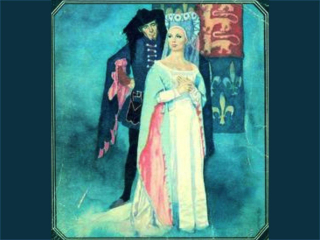 The whole period was distinguished by the emergence of powerful women. On centre stage, sizing and utilising power were Henry VI’s wife Margaret of Anjou, Edward IV’s wife Elizabeth Woodville and Henry VII’s mother Margaret Beaufort. Towards the end of the period the tradition continued with the brief reign of Anne Boleyn as Marchioness of Pembroke and Queen of England.
However five other women had a significant influence on events. The Perez sisters Constance and Isabelle, the de Roet sisters Catherine and Phillipa and last but not least Alice Perrers ( another Perez?). These five women all came from outside the established aristocracy and at times appeared to work in concert to influence first King Edward, then Bolingbrokes father, John of Gaunt and eventually Richard II. To everything Bolingbroke did can be assigned the secondary aim of destroying the power of these women.
The whole period was distinguished by the emergence of powerful women. On centre stage, sizing and utilising power were Henry VI’s wife Margaret of Anjou, Edward IV’s wife Elizabeth Woodville and Henry VII’s mother Margaret Beaufort. Towards the end of the period the tradition continued with the brief reign of Anne Boleyn as Marchioness of Pembroke and Queen of England.
However five other women had a significant influence on events. The Perez sisters Constance and Isabelle, the de Roet sisters Catherine and Phillipa and last but not least Alice Perrers ( another Perez?). These five women all came from outside the established aristocracy and at times appeared to work in concert to influence first King Edward, then Bolingbrokes father, John of Gaunt and eventually Richard II. To everything Bolingbroke did can be assigned the secondary aim of destroying the power of these women.
The whole period was distinguished by the emergence of powerful women. On centre stage, sizing and utilising power were Henry VI’s wife Margaret of Anjou, Edward IV’s wife Elizabeth Woodville and Henry VII’s mother Margaret Beaufort. Towards the end of the period the tradition continued with the brief reign of Anne Boleyn as Marchioness of Pembroke and Queen of England.
However five other women had a significant influence on events. The Perez sisters Constance and Isabelle, the de Roet sisters Catherine and Phillipa and last but not least Alice Perrers ( another Perez?). These five women all came from outside the established aristocracy and at times appeared to work in concert to influence first King Edward, then Bolingbrokes father, John of Gaunt and eventually Richard II. To everything Bolingbroke did can be assigned the secondary aim of destroying the power of these women.
Kings and Battles
 Despite continuing conflict there were only five changes to the succession brought about directly by the various battles. The futility of the fighting and the short term changes in fortune can be judged by the fact that both Edward IV and Henry IV ruled for two separate periods. The conflict extended far beyond the period normally assigned as “Wars of the Roses’ by conventional histories. The major battles cannot be separated from the context of the family tensions and external influences which led to the conflict, or from the ruthless way the Tudor dynasty, once it came to power, systematically eliminated all potential competitors.Despite continuing conflict there were only five changes to the succession brought about directly by the various battles. The futility of the fighting and the short term changes in fortune can be judged by the fact that both Edward IV and Henry IV ruled for two separate periods. The conflict extended far beyond the period normally assigned as “Wars of the Roses’ by conventional histories. The major battles cannot be separated from the context of the family tensions and external influences which led to the conflict, or from the ruthless way the Tudor dynasty, once it came to power, systematically eliminated all potential competitors.
Despite continuing conflict there were only five changes to the succession brought about directly by the various battles. The futility of the fighting and the short term changes in fortune can be judged by the fact that both Edward IV and Henry IV ruled for two separate periods. The conflict extended far beyond the period normally assigned as “Wars of the Roses’ by conventional histories. The major battles cannot be separated from the context of the family tensions and external influences which led to the conflict, or from the ruthless way the Tudor dynasty, once it came to power, systematically eliminated all potential competitors.Despite continuing conflict there were only five changes to the succession brought about directly by the various battles. The futility of the fighting and the short term changes in fortune can be judged by the fact that both Edward IV and Henry IV ruled for two separate periods. The conflict extended far beyond the period normally assigned as “Wars of the Roses’ by conventional histories. The major battles cannot be separated from the context of the family tensions and external influences which led to the conflict, or from the ruthless way the Tudor dynasty, once it came to power, systematically eliminated all potential competitors.
Richard II
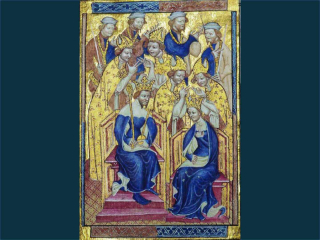 The initiating incident was that Henry Bolingbroke, who in 1400 was third in line to the throne, declared that he had a better claim to the throne than even the encumbant, Richard II. Shakespeare’s Play indicates that he was an extravagant, wasteful king preoccupied with fashion, sliding towards paranoia and despotism. Henry had, according to Shakespeare no alternative but to “save” the country by deposing Richard. He did not However order Richard’s death and when he learned of it swore to make reparation by going on a pilgramage.
Until quite recently the majority of students studied Shakespeare at secondary school and so this story has become widely accepted as history. However current research may tell a totally different story.The initiating incident was that Henry Bolingbroke, who in 1400 was third in line to the throne, declared that he had a better claim to the throne than even the encumbant, Richard II. Shakespeare’s Play indicates that he was an extravagant, wasteful king preoccupied with fashion, sliding towards paranoia and despotism. Henry had, according to Shakespeare no alternative but to “save” the country by deposing Richard. He did not However order Richard’s death and when he learned of it swore to make reparation by going on a pilgramage.
The initiating incident was that Henry Bolingbroke, who in 1400 was third in line to the throne, declared that he had a better claim to the throne than even the encumbant, Richard II. Shakespeare’s Play indicates that he was an extravagant, wasteful king preoccupied with fashion, sliding towards paranoia and despotism. Henry had, according to Shakespeare no alternative but to “save” the country by deposing Richard. He did not However order Richard’s death and when he learned of it swore to make reparation by going on a pilgramage.
Until quite recently the majority of students studied Shakespeare at secondary school and so this story has become widely accepted as history. However current research may tell a totally different story.The initiating incident was that Henry Bolingbroke, who in 1400 was third in line to the throne, declared that he had a better claim to the throne than even the encumbant, Richard II. Shakespeare’s Play indicates that he was an extravagant, wasteful king preoccupied with fashion, sliding towards paranoia and despotism. Henry had, according to Shakespeare no alternative but to “save” the country by deposing Richard. He did not However order Richard’s death and when he learned of it swore to make reparation by going on a pilgramage.
Until quite recently the majority of students studied Shakespeare at secondary school and so this story has become widely accepted as history. However current research may tell a totally different story.
The Inheritance
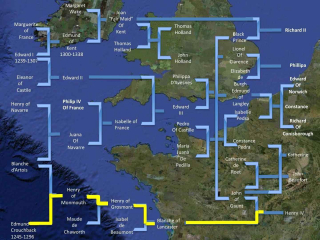 Henry Bolingbroke made his claim to the throne “In the name of my mother not my father”, admitting that he was in fact disinheriting every other member of the royal family including his own father. The subsequent Co-ordination of events makes it virtually certain that he was responsible for Richards murder.
Bolingbroke used parliamentary approval as the mechanism for his takeover, in itself a total change of precedent. As Henry IV he founded a new dynasty, but unfortunately a dynasty which was not particularly fertile.
When his grandson Henry VI suffered a mental breakdown, the succession was once again in doubt. Attempts to control the enfeebled King and doubts about
the succession led to thirty years of warfare and generations of legalised murder.
Recent opinion has swung against Henry Bolingbroke and regards him and his Lancastrian successors as usurpers of the throne. Nevertheless investigation of his claim and the subsequent Tudor claim shows that the claim, if not the means of pursuing the claim, cannot be dismissed out of hand.Henry Bolingbroke made his claim to the throne “In the name of my mother not my father”, admitting that he was in fact disinheriting every other member of the royal family including his own father. The subsequent Co-ordination of events makes it virtually certain that he was responsible for Richards murder.
Henry Bolingbroke made his claim to the throne “In the name of my mother not my father”, admitting that he was in fact disinheriting every other member of the royal family including his own father. The subsequent Co-ordination of events makes it virtually certain that he was responsible for Richards murder.
Bolingbroke used parliamentary approval as the mechanism for his takeover, in itself a total change of precedent. As Henry IV he founded a new dynasty, but unfortunately a dynasty which was not particularly fertile.
When his grandson Henry VI suffered a mental breakdown, the succession was once again in doubt. Attempts to control the enfeebled King and doubts about
the succession led to thirty years of warfare and generations of legalised murder.
Recent opinion has swung against Henry Bolingbroke and regards him and his Lancastrian successors as usurpers of the throne. Nevertheless investigation of his claim and the subsequent Tudor claim shows that the claim, if not the means of pursuing the claim, cannot be dismissed out of hand.Henry Bolingbroke made his claim to the throne “In the name of my mother not my father”, admitting that he was in fact disinheriting every other member of the royal family including his own father. The subsequent Co-ordination of events makes it virtually certain that he was responsible for Richards murder.
Bolingbroke used parliamentary approval as the mechanism for his takeover, in itself a total change of precedent. As Henry IV he founded a new dynasty, but unfortunately a dynasty which was not particularly fertile.
When his grandson Henry VI suffered a mental breakdown, the succession was once again in doubt. Attempts to control the enfeebled King and doubts about
the succession led to thirty years of warfare and generations of legalised murder.
Recent opinion has swung against Henry Bolingbroke and regards him and his Lancastrian successors as usurpers of the throne. Nevertheless investigation of his claim and the subsequent Tudor claim shows that the claim, if not the means of pursuing the claim, cannot be dismissed out of hand.
The Irish Question
 Henry Bolingbroke made his claim to the throne “In the name of my mother not my father”, admitting that he was in fact disinheriting every other member of the royal family including his own father. The subsequent Co-ordination of events makes it virtually certain that he was responsible for Richards murder.
Bolingbroke used parliamentary approval as the mechanism for his takeover, in itself a total change of precedent. As Henry IV he founded a new dynasty, but unfortunately a dynasty which was not particularly fertile.
When his grandson Henry VI suffered a mental breakdown, the succession was once again in doubt. Attempts to control the enfeebled King and doubts about
the succession led to thirty years of warfare and generations of legalised murder.
Recent opinion has swung against Henry Bolingbroke and regards him and his Lancastrian successors as usurpers of the throne. Nevertheless investigation of his claim and the subsequent Tudor claim shows that the claim, if not the means of pursuing the claim, cannot be dismissed out of hand.The Irish have songs tales and poetry about their lost independance. The Battle of Clontarf, where Brian Baru defeated the Vikings, but lost his own life; The Battle of Waterford where the English first took control of a blessed piece of Irish soil. The Battle of Athenry when the English wiped out the Irish Aristocracy. The battle of Cnoc Tuagh(Knocktoe) where the Gaels of the West suffered a horrendous loss to the Earls of the East.
Henry Bolingbroke made his claim to the throne “In the name of my mother not my father”, admitting that he was in fact disinheriting every other member of the royal family including his own father. The subsequent Co-ordination of events makes it virtually certain that he was responsible for Richards murder.
Bolingbroke used parliamentary approval as the mechanism for his takeover, in itself a total change of precedent. As Henry IV he founded a new dynasty, but unfortunately a dynasty which was not particularly fertile.
When his grandson Henry VI suffered a mental breakdown, the succession was once again in doubt. Attempts to control the enfeebled King and doubts about
the succession led to thirty years of warfare and generations of legalised murder.
Recent opinion has swung against Henry Bolingbroke and regards him and his Lancastrian successors as usurpers of the throne. Nevertheless investigation of his claim and the subsequent Tudor claim shows that the claim, if not the means of pursuing the claim, cannot be dismissed out of hand.The Irish have songs tales and poetry about their lost independance. The Battle of Clontarf, where Brian Baru defeated the Vikings, but lost his own life; The Battle of Waterford where the English first took control of a blessed piece of Irish soil. The Battle of Athenry when the English wiped out the Irish Aristocracy. The battle of Cnoc Tuagh(Knocktoe) where the Gaels of the West suffered a horrendous loss to the Earls of the East.All of these battles were however tainted with internecine conflicts between clans and Septs. The possibility of true unfettered independence came with the inspired leadership given by the Yorkist claimants during the wars of the Roses.
During the whole period of the Lancastrian rule Ireland gradually moved toward support for the alternative Yorkist contenders. Ireland became a power base and a place of refuge for Yorkists when under pressure and from 1460 onwards the Geraldine Earls of Kildare came close to achieving total independence. They became “High Kings” in everything but name.
Therefore perhaps the most significant battle for the Irish was the battle of Bosworth field which brought the Tudor Dynasty into power, for that is where the opportunity created by the Geraldine’s was lost.
It could even be said that Ireland’s destiny was finally changed at a masked ball held in Hampton Court where another powerful woman, Elizabeth Grey acting on the orders of HenryVIII, seduced the Earl of Kildare and set the Geraldine’s on a completely different course of compliance with the Tudor monarch.
It only then remained to execute the Earl’s eldest son by an earlier marriage (Silken Thomas)(and every one of the Earl’s five brothers) to extinguish the flame of independance and impose a new religion and a new sovereignty on the unwilling Irish.
The Kings of Mann
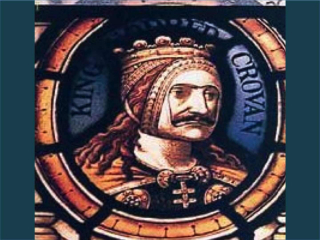 Though the English Kings rarely saw Ireland as a threat, they clearly valued its potential as an ally ( or perhaps just as a source of income). The evidence of this is that a large number of Lords Lieutenant were drawn from the Royal Family itself. This tradition started with John Lackland, son of Henry II. It is particularly true of the period leading up to the Wars of the Roses when between 1377 and 1415 when the only Non-Royal Lord Lieutenant was John Stanley.
According to the history kept by the Stanley family themselves ( and available from the Isle of Mann Web site) and John Stanley was the son of a forester, with no greater prospects than a patch of land to farm, when he was plucked out of obscurity by a distant relative, Lord James Audley, and inducted into the Black Princes army in Aquitaine.
The Stanley history puts his appointment as Lord Lieutenant as simply the result of hard work , courage and loyalty, an admirable story which has great attraction for those seeking a role model. Before the end of his life he was created King of the Isle of Mann.
However the contrast between the status of John Stanley and the other Lords Lieutenants which raises questions of who he was and why he was chosen. He appears to have carried out the groundwork for support for Richard II and therefore for the later acceptance of the Yorkist claim. Who was he and who influenced him in the actions he took?Though the English Kings rarely saw Ireland as a threat, they clearly valued its potential as an ally ( or perhaps just as a source of income). The evidence of this is that a large number of Lords Lieutenant were drawn from the Royal Family itself. This tradition started with John Lackland, son of Henry II. It is particularly true of the period leading up to the Wars of the Roses when between 1377 and 1415 when the only Non-Royal Lord Lieutenant was John Stanley.
Though the English Kings rarely saw Ireland as a threat, they clearly valued its potential as an ally ( or perhaps just as a source of income). The evidence of this is that a large number of Lords Lieutenant were drawn from the Royal Family itself. This tradition started with John Lackland, son of Henry II. It is particularly true of the period leading up to the Wars of the Roses when between 1377 and 1415 when the only Non-Royal Lord Lieutenant was John Stanley.
According to the history kept by the Stanley family themselves ( and available from the Isle of Mann Web site) and John Stanley was the son of a forester, with no greater prospects than a patch of land to farm, when he was plucked out of obscurity by a distant relative, Lord James Audley, and inducted into the Black Princes army in Aquitaine.
The Stanley history puts his appointment as Lord Lieutenant as simply the result of hard work , courage and loyalty, an admirable story which has great attraction for those seeking a role model. Before the end of his life he was created King of the Isle of Mann.
However the contrast between the status of John Stanley and the other Lords Lieutenants which raises questions of who he was and why he was chosen. He appears to have carried out the groundwork for support for Richard II and therefore for the later acceptance of the Yorkist claim. Who was he and who influenced him in the actions he took?Though the English Kings rarely saw Ireland as a threat, they clearly valued its potential as an ally ( or perhaps just as a source of income). The evidence of this is that a large number of Lords Lieutenant were drawn from the Royal Family itself. This tradition started with John Lackland, son of Henry II. It is particularly true of the period leading up to the Wars of the Roses when between 1377 and 1415 when the only Non-Royal Lord Lieutenant was John Stanley.
According to the history kept by the Stanley family themselves ( and available from the Isle of Mann Web site) John Stanley was the son of a forester, with no greater prospects than a patch of land to farm, when he was plucked out of obscurity by a distant relative, Lord James Audley, and inducted into the Black Princes army in Aquitaine.
The Stanley history puts his appointment as Lord Lieutenant as simply the result of hard work , courage and loyalty, an admirable story which has great attraction for those seeking a role model. Before the end of his life he was created King of the Isle of Mann.
However the contrast between the status of John Stanley and the other Lords Lieutenants which raises questions of who he was and why he was chosen. He appears to have carried out the groundwork for support for Richard II and therefore for the later acceptance of the Yorkist claim. Who was he and who influenced him in the actions he took?
The Aftermath
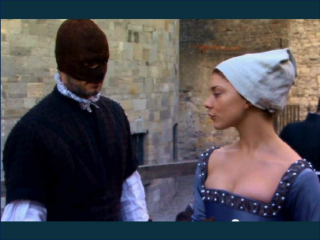 There was no shortage of Yorkist claimants to the throne. Henry VIII set about eliminating them all. Henry VIII was also supposed to have married six wives in a desperate search for a male heir but their was possibly something else going on. Every one of his six wives was a descendant of Edward I. Was it possible he was trying to avoid the possibility of them breeding with anyone else and therefore creating potential competitors?
He did not entirely succeed as many descendants of the Yorkists survive through until the present day. They are not however the only claimants. Parliament did not hesitate to pick up on the precedent set by Henry Bolingbroke. Edward VI, son of Henry VIII chose Lady Jane Grey as his successor. Much good did it do her. She was executed after only nine days on the throne. Edward was trying to protect the reformed church from an attack by his sister Mary who was a devoted follower of the Church of Rome but perhaps also trying to implement his fathers will. Henry VIII specifically left the succession to the descendants of his sister Mary, and thus to Jane, not to his sister Margaret. Elizabeth I also lived true to his wishes and executed Margaret’s daughter, Mary, Queen of Scots for even thinking about her rights to succession, should Elizabeth die childless. Parliament however ignored the will and ultimately awarded the throne to Mary’s son James Stewart. Even today there are are claimants to both the “Yorkist” and the “Henrican succession”. What emerged was an acceptance that it was futile and extremely dangerous to challenge the succession approved by Parliament.There was no shortage of Yorkist claimants to the throne. Henry VIII set about eliminating them all. Henry VIII was also supposed to have married six wives in a desperate search for a male heir but their was possibly something else going on. Every one of his six wives was a descendant of Edward I. Was it possible he was trying to avoid the possibility of them breeding with anyone else and therefore creating potential competitors?
There was no shortage of Yorkist claimants to the throne. Henry VIII set about eliminating them all. Henry VIII was also supposed to have married six wives in a desperate search for a male heir but their was possibly something else going on. Every one of his six wives was a descendant of Edward I. Was it possible he was trying to avoid the possibility of them breeding with anyone else and therefore creating potential competitors?
He did not entirely succeed as many descendants of the Yorkists survive through until the present day. They are not however the only claimants. Parliament did not hesitate to pick up on the precedent set by Henry Bolingbroke. Edward VI, son of Henry VIII chose Lady Jane Grey as his successor. Much good did it do her. She was executed after only nine days on the throne. Edward was trying to protect the reformed church from an attack by his sister Mary who was a devoted follower of the Church of Rome but perhaps also trying to implement his fathers will. Henry VIII specifically left the succession to the descendants of his sister Mary, and thus to Jane, not to his sister Margaret. Elizabeth I also lived true to his wishes and executed Margaret’s daughter, Mary, Queen of Scots for even thinking about her rights to succession, should Elizabeth die childless. Parliament however ignored the will and ultimately awarded the throne to Mary’s son James Stewart. Even today there are are claimants to both the “Yorkist” and the “Henrican succession”. What emerged was an acceptance that it was futile and extremely dangerous to challenge the succession approved by Parliament.There was no shortage of Yorkist claimants to the throne. Henry VIII set about eliminating them all. Henry VIII was also supposed to have married six wives in a desperate search for a male heir but their was possibly something else going on. Every one of his six wives was a descendant of Edward I. Was it possible he was trying to avoid the possibility of them breeding with anyone else and therefore creating potential competitors?He did not entirely succeed as many descendants of the Yorkists survive through until the present day. They are not however the only claimants. Parliament did not hesitate to pick up on the precedent set by Henry Bolingbroke. Edward VI, son of Henry VIII chose Lady Jane Grey as his successor. Much good did it do her. She was executed after only nine days on the throne. Edward was trying to protect the reformed church from an attack by his sister Mary who was a devoted follower of the Church of Rome but perhaps also trying to implement his fathers will. Henry VIII specifically left the succession to the descendants of his sister Mary, and thus to Jane, not to his sister Margaret. Elizabeth I also lived true to his wishes and executed Margaret’s daughter, Mary, Queen of Scots for even thinking about her rights to succession, should Elizabeth die childless. Parliament however ignored the will and ultimately awarded the throne to Mary’s son James Stewart. Even today there are are claimants to both the “Yorkist” and the “Henrican succession”. What emerged was an acceptance that it was futile and extremely dangerous to challenge the succession approved by Parliament.
